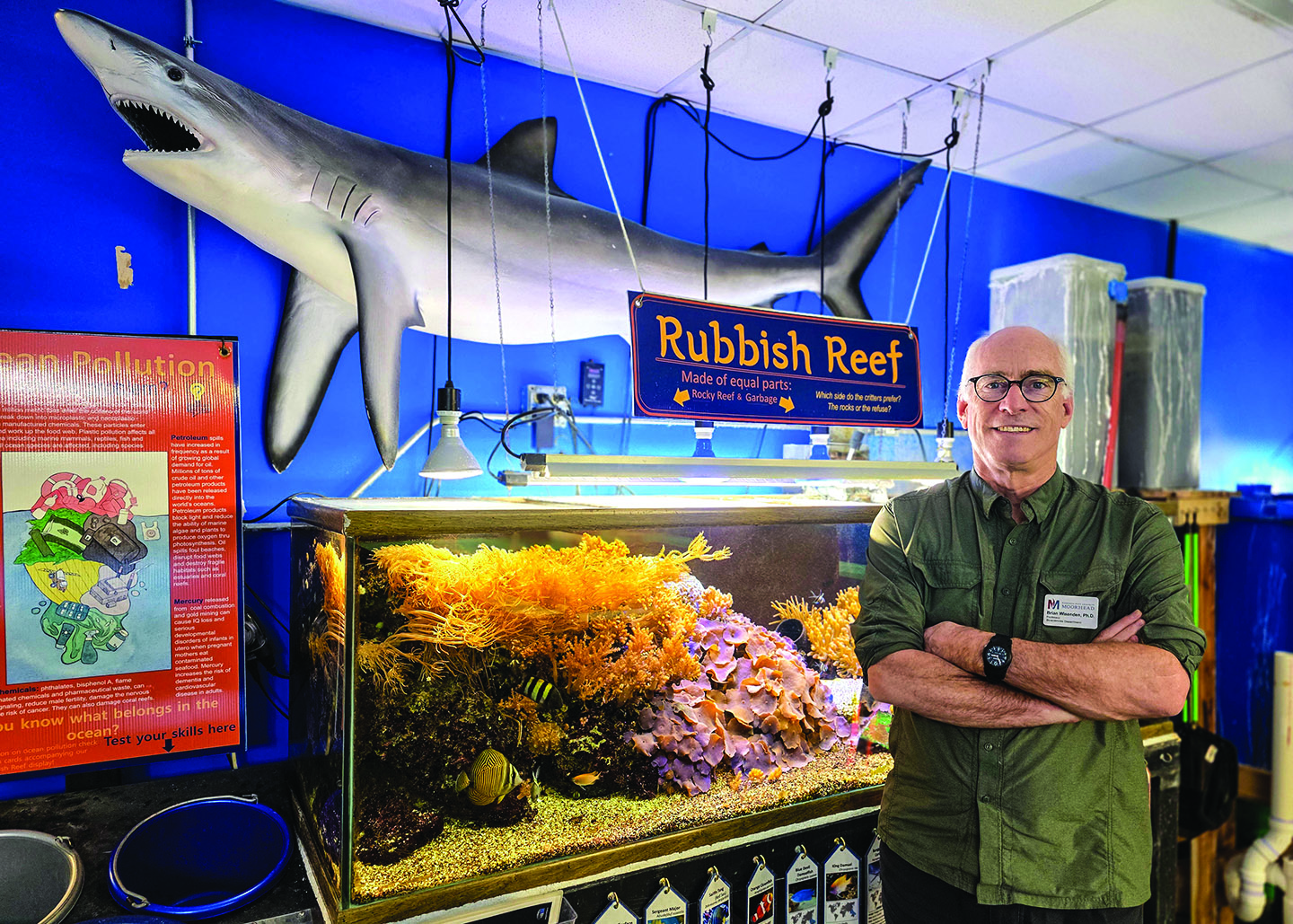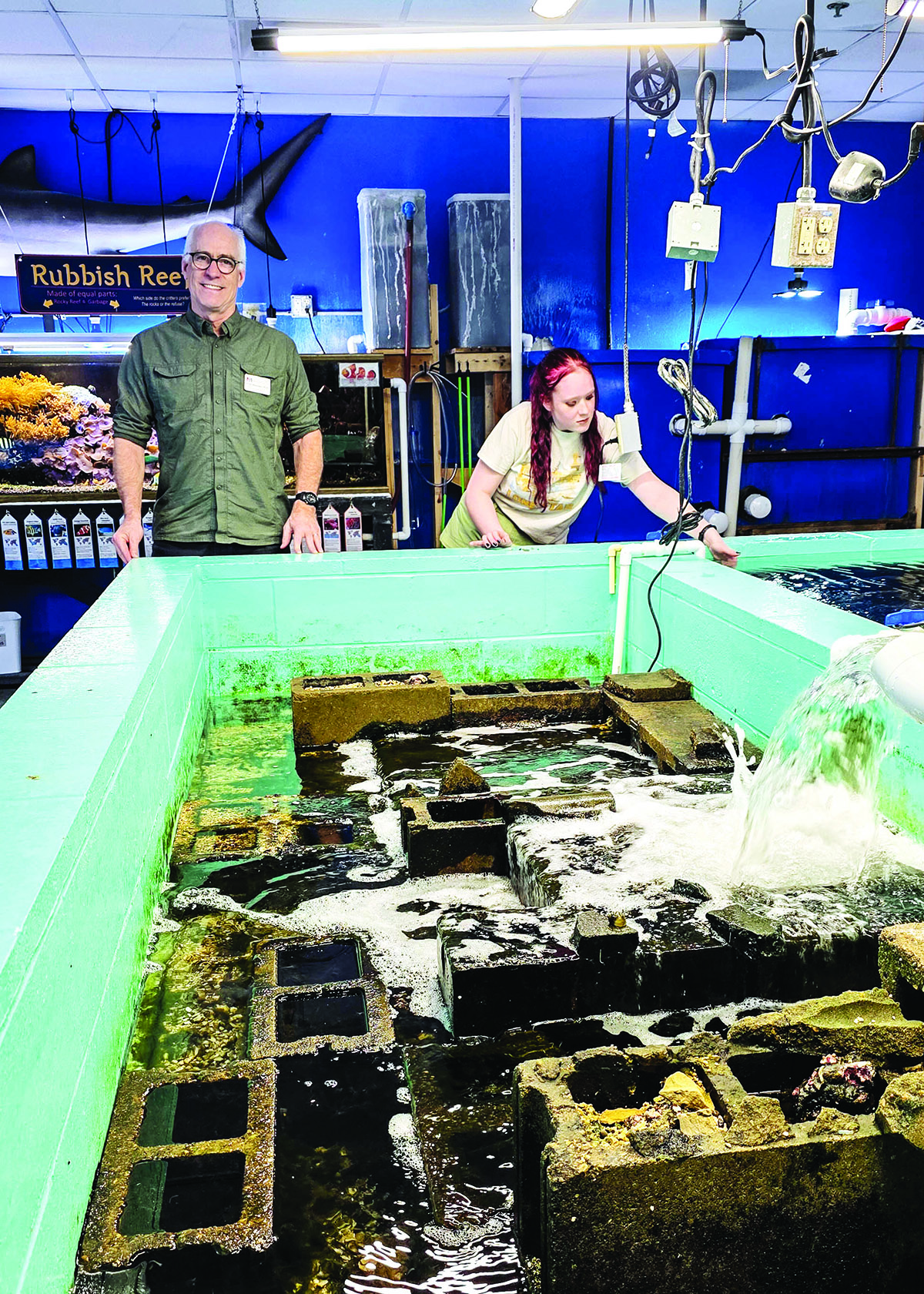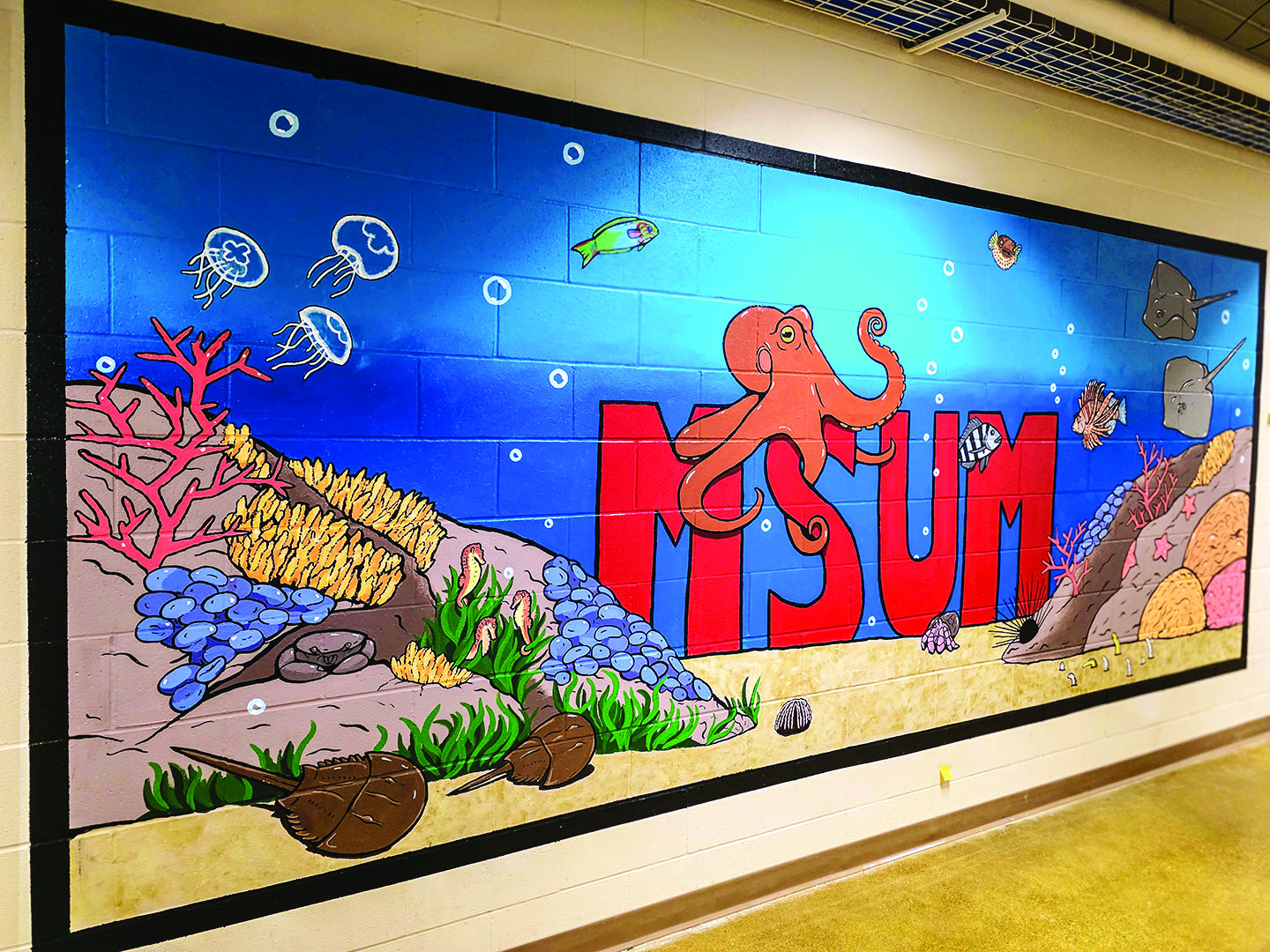
Dr. Brian Wisenden, who teaches biosciences at MSUM, and his students have built the Oceanarium, where Midwesterners can view — and even touch — salt-water creatures half a continent away from the seashore. (Photos/Nancy Hanson.)

Prof. Wisenden and student volunteer Meredith Burschett observe the tide coming in. The large tanks simulate a tidal pool, with the water level rising and falling as it does on the ocean shoreline.
Nancy Edmonds Hanson
Fifteen hundred miles from an ocean, students are glimpsing life below the sea.
Marine life is flourishing in the lower level of Minnesota State University’s Langseth Hall. There, the Oceanarium – begun 11 years ago as a class study of the hardy life that flourishes in oceanfront tidal pools – maintains a growing aquatic zoo of creatures far from their native waters.
What’s now the Oceanarium began as an extension of biosciences professor Brian Wisenden’s annual class sojourns to the warm waters of Costa Rica. “We’ve been taking marine life classes there since 2002,” he says. He himself had been doing research there since 1988. When a student expressed interest in animals that thrived within the dramatic wet-to-dry-to wet cycles of the ocean tide, he turned a corner of the research area into a man-made version. Concrete-block tanks are flushed with salt water every three minutes, simulating the pull of sun and moon on the shoreline, draining to low tide before the next high tide comes.
Small organisms are trapped in the researchers’ pools – little fish, sea stars, crustaceans, octopi, eels. “It’s very interesting to watch and touch them,” Wisenden says with understatement. And that was the start.
Other students suggested other animals to study: Stingrays, jellyfish, puffer fish, horseshoe crabs (which aren’t crabs at all, but relatives of scorpions and spiders). The growing Marine Ecology Lab in the Langseth Hall basement attracted more and more attention. Students formed the Marine Ecology Club, signing up for 24/7 shifts feeding the organisms and checking water salted to oceanic levels.
Along with biosciences students, including those majoring in Curious groups began to visit the lab to learn about ocean creatures. “In the middle of the continent, live marine organisms are quite a novelty,” the professor observes. His students began introducing groups of kids from schools, the library and the YMCA to the unfamiliar faces (and otherwise) of undersea natives.
“But saltwater aquariums are very expensive to maintain. We tried several approaches to fund it,” says Wisenden. Then, as now, the marine life lab had to be self-supporting. “And then COVID happened, and we were shut down.”
Post-pandemic, the lab reopened as the Oceanarium. “We decided to switch from focusing on in-house courses to an outward-facing facility for the community. It was the only way to generate the numbers of paid admissions to cover the cost of all this,” he says, gesturing to what has become a complex of oversized tanks, aquarium and displays.
Along with admission of $5 per person for tour groups of from one to four dozen people, individuals and families can visit during open houses from 1 to 4 p.m. every Saturday. Marine science students – many of them not official bioscience majors – lead tours and offer insights into the sometimes-bizarre creatures visitors meet there. To book tours, go to www.mnstate.edu/oceanarium.
Community supporters, too, have contributed to building the Oceanarium, among them Bob and Lori Seigel, who donated funds for the new Touch Tank; Jeanne Aske, president of the Oceanarium Advisory Board; and the Moorhead Lions Club. The service organization funded the specialized tank that houses – naturally – the lion fish. Wisenden is currently looking for a corporate sponsor for the planned shark tank.
While attracting some 5,000 off-campus visitors each year, the Oceanarium has grown into a magnet for students interested in marine life, but looking for a program closer to home. It has grown – says Wisenden – from the germ of an idea into a full-blown program. Some 40 current students are pursuing a bachelor’s degree in biology with an emphasis in ecology and evolutionary biology. Many are preparing for careers as aquarists, professionals who care for and manage aquariums in various settings, including public aquariums, nature reserves, zoos and even pet stores.
One EEB graduate, Katie Hanson, worked as a zookeeper for several years after graduation before joining the Kansas City Public Aquarium, one of the nation’s largest. After returning to Moorhead, she joined her old program as the Oceanarium’s coordinator, supervising the college students who care for its denizens and answer visitors’ questions.
The Oceanarium also hosts a Junior Aquarist Camp for Kids as part of MSUM’s summer college for Kids. Ten JACK sessions are planned in coming months for two ages. Sessions for the younger group, ages 8 to 11, are already full; some openings remain for 11- to 14-year-olds. Online registration is at www.mnstate.edu/about/engaged-learning/college-for-kids-teens/classes.
While marine life is the Oceanarium’s focus, Wisenden’s own research into animal behavior focuses on their freshwater brethren. “I’m a fish guy,” he proclaims. In addition to research in his lab next door to the Oceanarium, he spends summers as the University of Minnesota’s Itasca Biological Station and Lab, an assignment he’s held since 2000.
During the other nine months, he’s passionate about opening the public’s eyes to the importance and the fascination of the ocean. “We don’t necessarily have very much contact, especially so far from the coasts,” he points out. His mission, he says, is to make Midwesterners aware of how much the ocean impacts life here in Moorhead … and how we affect the ocean.
“There’s a very strong connection between the ocean’s health and our own health,” he says. “Almost three-fourths of Earth’s surface is covered by its water. It’s a massive thermal battery that regulates heat and water all across the planet.
“Rain, temperature, the air we breathe – they all ultimately come from the ocean.”



